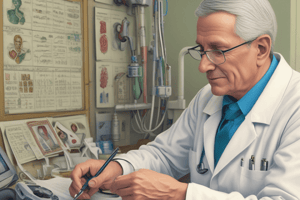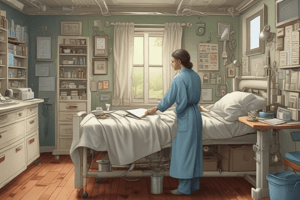Podcast
Questions and Answers
What are the 4 goals of assessment?
What are the 4 goals of assessment?
- Evaluate the patient (correct)
- Gather key info (correct)
- Learn the history (correct)
- Learn overall health (correct)
What key patient information do you gather first?
What key patient information do you gather first?
Name, age, gender, race
What is the chief complaint?
What is the chief complaint?
Major symptom reported by patient regardless of overall significance
What is a symptom?
What is a symptom?
What is a sign?
What is a sign?
What is SAMPLE History?
What is SAMPLE History?
What does OPQRST stand for?
What does OPQRST stand for?
Baseline vitals always include what?
Baseline vitals always include what?
What vitals likely include?
What vitals likely include?
What are the 6 assessments of respirations?
What are the 6 assessments of respirations?
What are normal respirations for an adult?
What are normal respirations for an adult?
What are normal respirations for a child?
What are normal respirations for a child?
What are normal respirations for an infant?
What are normal respirations for an infant?
What is pulse oximetry?
What is pulse oximetry?
What are the 3 pulse assessments?
What are the 3 pulse assessments?
What is the normal pulse for an adult?
What is the normal pulse for an adult?
What is the normal pulse for children?
What is the normal pulse for children?
What is the normal pulse for an infant?
What is the normal pulse for an infant?
What are the 3 skin assessments?
What are the 3 skin assessments?
How do you check capillary refill?
How do you check capillary refill?
What does a drop in BP indicate?
What does a drop in BP indicate?
What is diastolic pressure?
What is diastolic pressure?
What is systolic pressure?
What is systolic pressure?
BP is measured as?
BP is measured as?
What is a healthy BP?
What is a healthy BP?
What does AVPU stand for?
What does AVPU stand for?
What does PEARRL stand for?
What does PEARRL stand for?
How often do you reassess a stable patient?
How often do you reassess a stable patient?
How often do you assess an unstable patient?
How often do you assess an unstable patient?
What are the 5 main parts of patient assessment?
What are the 5 main parts of patient assessment?
What are the 6 aspects of BSI?
What are the 6 aspects of BSI?
What are 7 things to look for in Scene Size up?
What are 7 things to look for in Scene Size up?
What are examples of potential hazards?
What are examples of potential hazards?
What are the 5 aspects of scene safety?
What are the 5 aspects of scene safety?
What does MOI stand for?
What does MOI stand for?
What does NOI stand for?
What does NOI stand for?
What is a symptom?
What is a symptom?
What is a sign?
What is a sign?
What are additional resources you may call for?
What are additional resources you may call for?
Flashcards are hidden until you start studying
Study Notes
Goals of Assessment
- Gather key information regarding the patient's condition.
- Evaluate the patient's health status systematically.
- Understand the patient's medical history.
- Assess overall health to inform treatment decisions.
Key Patient Information
- Essential details to collect include name, age, gender, and race.
Chief Complaint
- The primary symptom reported by the patient, which may not reflect its overall significance.
Symptoms and Signs
- Symptoms are problems or complaints indicated by the patient.
- Signs are observable conditions that can be seen, heard, felt, smelled, or measured.
SAMPLE History
- Acronym representing key history elements:
- Signs/Symptoms
- Allergies
- Medications
- Pertinent past history
- Last oral intake
- Events leading to illness/injury
OPQRST
- A mnemonic for assessing pain:
- Onset
- Provocation
- Quality
- Radiation
- Severity
- Time
Baseline Vital Signs
- Always includes:
- Respiration rate
- Pulse
- Blood Pressure (BP)
- Lung sounds
Additional Vital Signs
- May include skin temperature, capillary refill, pupil response, and level of consciousness (LOC).
Respiratory Assessment
- Assessments should include rate, quality, rhythm, effort, noise, and depth.
- Normal adult respiration: 12-20 breaths per minute.
- Normal child respiration: 15-30 breaths per minute.
- Normal infant respiration: 25-50 breaths per minute.
Pulse Oximetry
- Measures oxygen saturation of hemoglobin; normal reading is 95% or higher.
- Assess pulse based on rate, strength (bounding, strong, thready), and regularity.
Normal Pulse Rates
- Adult pulse: 60-100 beats per minute (bpm).
- Child pulse: 70-150 bpm.
- Infant pulse: 100-160 bpm.
Skin Assessment
- Evaluate color, temperature, and moisture of the skin.
Capillary Refill Check
- Squeeze the tip of a finger for 2 seconds, then release.
- Poor perfusion is indicated if refill takes longer than 2 seconds; useful in pediatric assessments.
Blood Pressure Insights
- A drop in blood pressure can indicate:
- Blood loss
- Loss of vascular tone
- Cardiac pumping issues.
- Diastolic pressure indicates relaxation of ventricles; systolic pressure indicates blood pressure during ventricular contraction.
- Blood pressure expressed as systolic/diastolic in mmHg, with a healthy reading at 120/80.
Patient Assessment Methodology
- AVPU scale: Alert, Verbal, Pain response, Unresponsive.
- PEARRL assessment for pupils: Equal and round, regular in size, reactive to light.
Reassessment Intervals
- Stable patients require reassessment every 15 minutes.
- Unstable patients should be reassessed every 5 minutes.
Patient Assessment Components
- Scene size-up
- Primary assessment
- History taking
- Secondary assessment
- Reassessment
Body Substance Isolation (BSI)
- Recognizes risks from all body fluids.
- Equipment includes gloves, eye protection, masks, and gowns.
Scene Size-Up Considerations
- Review dispatch information, inspect the scene, identify safety concerns, determine mechanism of injury/nature of illness, triage patients, and request additional resources.
Potential Hazards
- Be aware of oncoming traffic, unstable surfaces, gas leaks, electrical hazards, potential violence, fires, smoke, hazardous materials, and crime scenes.
Scene Safety Protocols
- Prioritize safety of personnel and bystanders, park in a safe area, communicate with law enforcement, and call for additional resources if necessary.
Mechanism of Injury (MOI) and Nature of Illness (NOI)
- Assess MOI to evaluate possible injury extent based on force, duration, and affected body areas.
- For NOI, gather clues and listen for the chief complaint.
Subjective vs. Objective Data
- Symptom: Subjective data reported by the patient, family, or bystander.
- Sign: Objective data that can be observed or measured directly.
Additional Resources
- Can include requests for additional units, air transport, non-medical support, fire suppression, and rescue services.
Studying That Suits You
Use AI to generate personalized quizzes and flashcards to suit your learning preferences.





